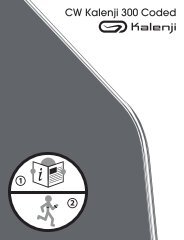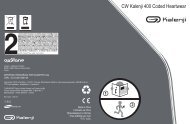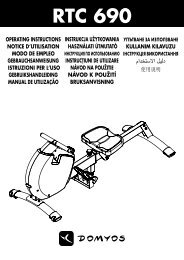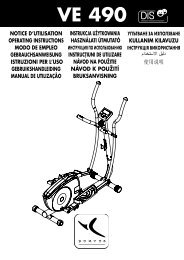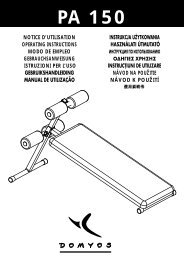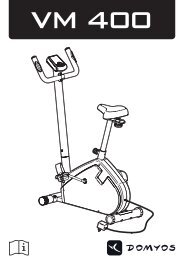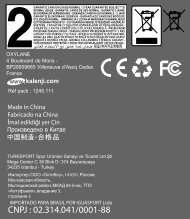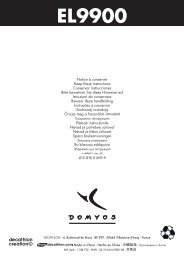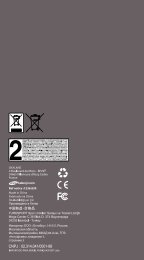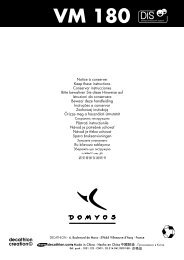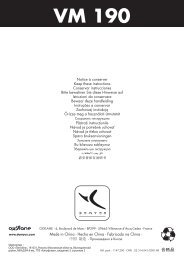Create successful ePaper yourself
Turn your PDF publications into a flip-book with our unique Google optimized e-Paper software.
enGlisH<br />
CARDIO-TRAINING<br />
Cardio training is aerobic exercise (muscle development using oxygen); it enables you to improve your cardiovascular capacity.<br />
More specifically, you improve the tone of your heart muscle and blood vessels.<br />
Cardiovascular training takes oxygen from the air you breathe into your muscles.<br />
The heart pumps this oxygen throughout the entire body, and especially to the muscles that are doing the work.<br />
CONTrOL YOUr PULSE rATE<br />
Taking your pulse regularly while exercising is essential for controlling<br />
your training.<br />
If you don’t have an electronic measuring instrument, this is how you do<br />
it :<br />
To take your pulse, place 2 fingers over :<br />
your neck, beneath the ear, or inside the wrist next to the thumb<br />
Don’t press too hard :<br />
a – Warm-up phase: progressive effort<br />
The warm-up is the preparatory phase for exercise and gets your body<br />
COMPLETELY READY to start working out.<br />
It is a way to PREVENT INJURIES TO TENDONS AND MUSCLES.<br />
It involves two stages:<br />
WAKING UP THE MUSCULAR SYSTEM, AND OVERALL WARM-UP.<br />
1) You wake up your muscles with a SERIES OF SPECIFIC STRETCHES that<br />
PREPARE YOU FOR EXERCISE: every muscle group is used, and the joints<br />
are stimulated.<br />
2) The overall warm-up makes it possible to put the cardio-vascular and<br />
respiratory system into action gradually, for a better blood supply to<br />
the muscles and better preparation for the exercise. It should be long<br />
enough: 10 minutes for a recreational sport, and 20 minutes for a competitive<br />
sport. Note that you should warm up for longer: in the morning<br />
and if you are over 55.<br />
Beats per minute<br />
Age<br />
22<br />
Pressing too hard lessens the blood flow and can slow down the heart<br />
rhythm.<br />
After counting the beats for 30 seconds, multiply by 2 to get the number<br />
of beats per minute.<br />
Example :<br />
A count of 75 beats gives 150 beats/minute<br />
PHASES OF PHYSICAL ACTIVITY<br />
B – training<br />
The workout is the main phase of your physical activity.<br />
By working out on a REGULAR basis, you can improve your physical fitness.<br />
• Anaerobic work for improving endurance.<br />
• Aerobic work for improving cardio-pulmonary strength.<br />
c – Warming down<br />
This corresponds to low-level activity; it is the gradual “resting” phase. WAR-<br />
MING DOWN returns your cardiovascular, respiratory and circulatory systems<br />
and your muscles to normal functioning (thereby preventing undesirable<br />
side effects such as the build-up of lactic acid, which is one of the major causes<br />
of muscle pain namely, cramps and stiffness).<br />
d - stretching<br />
You should stretch after warming down. Stretching after exercise: Minimises<br />
MUSCULAR STIFFNESS caused by the build-up of.<br />
caRdioVasculaR tRaininG: eXeRcise Zone<br />
• Training at 80 to 90% and over of maximum heart rate: Anaerobic and red zones reserved for competitive, specialist<br />
athletes.<br />
• Training at 70 to 80% of maximum heart rate: Endurance training.<br />
• Training at 60 to 70% of maximum heart rate: Getting fit/Burning off fat.<br />
• Training at 50 to 60% of maximum heart rate: Staying in shape/Warm-up.<br />
Male Beats per minute Female<br />
If your age differs from those given in the table, you can use the following formulae to calculate your maximum heart rate which corresponds to 100%.<br />
For men: 220 - age<br />
For women: 227 - age<br />
Age



